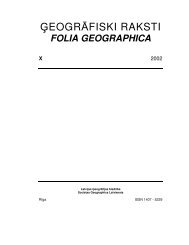eogrÄfiski raksti folia geographica xii - Ä¢eogrÄfijas un Zemes zinÄtņu ...
eogrÄfiski raksti folia geographica xii - Ä¢eogrÄfijas un Zemes zinÄtņu ...
eogrÄfiski raksti folia geographica xii - Ä¢eogrÄfijas un Zemes zinÄtņu ...
Create successful ePaper yourself
Turn your PDF publications into a flip-book with our unique Google optimized e-Paper software.
85<br />
LANDSCAPES AND CULTURE<br />
of that geography lesson, the story left a deep impression. A novel about a Dutch boy and the<br />
dykes of the Netherlands is lost in memory, as is a novel about an icebreaker captain, but these<br />
and many others were riveting reads with landscapes as powerful elements in the stories. A<br />
good deal of Latvian literature that I read as a child, adolescent, and adult incorporated<br />
landscapes, not only as scenes for story lines, but as profo<strong>un</strong>d, often active actors in the stories.<br />
Stories set in snow-covered landscapes, on ice on the sea, on lakes and on rivers left indelible<br />
imprints on my psyche. They contained not only action, but were bo<strong>un</strong>d up with moral issues<br />
and questions of being, life, and death. Rightly or wrongly, in a short story about a kid’s<br />
snowball fight [Poruks 2002], I learned of the painless death by freezing of a boy in a snowladen<br />
spruce forest.<br />
Years later, when I had beg<strong>un</strong> graduate studies in geography, I came across tantalizing bits of<br />
thought by Carl Sauer that hinted at the possibilities for imaginative perceptions and evocative<br />
writing in landscape geography. In “The morphology of landscape” (1963, 320) Sauer writes<br />
that geography’s task is to embrace “the phenomenology of landscape, in order grasp in all its<br />
meaning and color the varied terrestrial scene.” Although Sauer denies artistic endeavors in<br />
geography as idiosyncratic and thus <strong>un</strong>desirable to achieving systematic knowledge [Sauer<br />
1963, 331], later in the essay he avers that, “The best geography has never disregarded the<br />
esthetic qualities of landscape, to which we know no approach other than the subjective.”<br />
Indeed, Sauer observes that in the final analysis “some of the best… believe , that having<br />
observed widely and charted diligently, there yet remains a quality of <strong>un</strong>derstanding at a higher<br />
plane that may not be reduced to formal process” [Sauer 1963, 344-345].<br />
At the time that I read Sauer’s essay I was just beginning master’s studies and had no<br />
confidence that I would ever become a professional geographer, let alone explore human<br />
relationships with landscapes and with nature subjectively. But Sauer’s ideas stayed with me.<br />
When somewhat later I came across Ralph H. Brown’s Mirror for Americans: Likeness of the<br />
Eastern Seaboard (1810) [Brown 1943], I was excited, for I believed that here would be a<br />
subjective, imaginative book. It was a disappointment—Brown had written a solid work of<br />
historical geography, based on observations made at the time in question, but it was not<br />
literature.<br />
But major changes were afoot in geography in the sixties and seventies. Perception and literary<br />
studies were emerging. David Lowenthal’s “Geography, experience, and imagination: Towards<br />
a <strong>geographica</strong>l epistemology” (1961) was a seminal essay that made me think differently about<br />
culture, not as something monolithic and easily labeled, but instead as made up of a wide<br />
spectrum of perceptions and attitudes of different people within a particular culture group.<br />
David Lowenthal’s and Hugh C. Prince’s literary essay on “The English landscape” (1964), as<br />
well as Lowenthal’s “English landscape tastes” (1965) and “The American scene” (1968) all<br />
showed how literary evocations can be the basis for <strong>un</strong>derstanding and evaluating landscape<br />
perceptions and attitudes within a particular cultural milieu. In her “Grasping the dynamism of<br />
lifeworld” Anne Buttimer (1976) brought in the idea of studying the lived geographies of<br />
people. Of course, with his numerous articles and books, Yi-Fu Tuan literally threw the doors<br />
wide open to the study of human emotional and intellectual relationships with landscapes and<br />
environments. And then there was John Kirtland Wright’s profo<strong>un</strong>d essay on geography and<br />
imagination, written much earlier but republished in 1966 [Wright 1966], which seemed to tie<br />
together all these different strands of thought and sanctify the exploration of geography within a<br />
particular human being.<br />
The references just cited are not meant to be exhaustive. Nor do they include a much greater<br />
volume of literary and poetic works that have guided me, from those of Camus, Steinbeck,<br />
Hemingway, Rilke, Atwood, Siegfried Lenz, Neruda, and Czeslaw Milosz, to Barry Holst<strong>un</strong><br />
Lopez, Ivan Doig, Annie Dillard, and many others. Lopez was perhaps the most inspirational, in<br />
his fiction and non-fiction. His Arctic dreams: Imagination and desire in a northern landscape<br />
(1986) in particular made me wish to write substantially about the experience of landscapes, not<br />
necessarily emulative of Lopez, but in my own fashion.<br />
The first real venture came in the fall of 1983 at L<strong>un</strong>d University in Sweden. I was there on a<br />
sabbatical, investigating twentieth century literature as a source of culture-nature attitudes,<br />
intending to ultimately write a book on such attitudes. I was inspired to do so by my mentor,

















